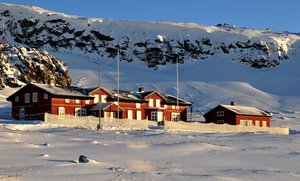Netherlands’ Arctic Station

Address
Netherlands Arctic StationP.O.Box 1
N-9173 Ny-Ålesund
Norway
Station manager
Maarten LoonenContact Station
www.rug.nl/arcticcentreStation Features
Opening year: 1995 Status: OpenFacilities
Station name and owner
The Netherlands’ Arctic Station is owned and run by the Arctic Centre of the University of Groningen.
Location
The Netherlands’ Arctic Station is situated in Kongsfjorden on the island of Spitsbergen and is part of an international research community in the former mining town of Ny-Ålesund, Svalbard. In this town, more than 10 nations have their own station while using shared facilities for meals and recreation. The whole local community is focussed on science and maintenance of infrastructure. Several stations have independent terrestrial research programmes and the Netherlands’ Arctic Station is the smallest of all.
Climate data
Grey colours are WMO Climate Normals including maximum and minimum values. Blue colours are individual years.
Climate data for the stations where extracted via Copernicus Climate Data Store, from the global gridded reanalysis product:
ERA5 monthly averaged data on single levels from 1940 to present.
Description and source code: Roemer J.K. 2023. https://doi.org/10.5281/zenodo.10214922
Data Source: Hersbach et al. 2023. Copernicus Climate Change Service (C3S) Climate Data Store (CDS), https://doi.org/10.24381/cds.f17050d7
Biodiversity and natural environment
Kongsfjorden is a beautiful high arctic environment with several glaciers terminating in the fjord. The raised beach terraces are sparsely vegetated with dense moss cover around small tundra lakes and below bird cliffs. Locally there are clear traces of former human activity by trappers and from coal mining. At present, the whole area is well-protected and a special permission is needed to enter the islands during the bird breeding season. In 1978, reindeer was re-introduced and since 1982 barnacle geese have established a colony and are regularly feeding between the houses. Both herbivores have a clear impact on the vegetation.
History and facilities
From 1916 to 1968, the village of Ny-Ålesund was a coal mining settlement. This village has now developed into a unique mix of stations, laboratories, and research infrastructure. There is a small international community of 25 to 180 people – all temporal residents. Tourists are discouraged to stay overnight. In 1990, the University of Groningen initiated a project on barnacle geese and later joined the shared facilities with the establishment of Netherlands’ Arctic Station. The station consists of two small buildings for lodging with electricity but no plumbing. Shared facilities in town offer unique high-standard science and logistic support. There is a developing cooperation with the local German/French base AWIPEV.
General research and databases
Research focusses on the role of barnacle geese in the arctic ecosystem. Nutrient cycles, plant productivity, and vegetation patterns are studied to understand plant-herbivore interactions. Behaviour, timing, and breeding success of individually ringed geese are observed over their lifetime, and the effect of predators is studied as a dynamic interaction. Population trends of plants, herbivores, and predators are monitored in a warming environment. Long term experiments include grazing exclosures and greenhouses on paired vegetation plots. There are also projects focussing on the history of human exploitation and the effect of tourism on cultural heritage.
Station Monitoring
Human dimension
The local community in Ny-Ålesund is a mixture of nationalities from the various stations. The area is owned by a company called Kings Bay, taking care of the logistics for the entire village. Ny-Ålesund has no permanent residents and all activity is linked to science. The closest town is the Norwegian village of Longyearbyen, which is the main hub of Svalbard. In Longyearbyen, permanent residents are few (c. 2100). There are no indigenous people and most inhabitants originate from the Norwegian mainland and live on Svalbard only because of their temporal job assignment. Tourism, local administration, science, and coal mining are the most important sources of income.
Access
Throughout the year, Kings Bay organises two flights per week with a small plane (14 passengers) between Longyearbyen and Ny-Ålesund. In summer, there are about 30000 tourists landing by boat for just a few hours. There is only a limited amount of roads near the village. Local transportation is possible by car, bicycle, snowmobile, or foot. Small boats are used for transportation inside the fjord.

